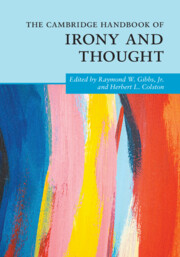Book contents
- The Cambridge Handbook of Irony and Thought
- Cambridge Handbooks in Psychology
- The Cambridge Handbook of Irony and Thought
- Copyright page
- Contents
- Contributors
- Part I Introduction
- Part II The Scope of Irony
- Part III Irony’s Impact
- Part IV Irony in Linguistic Communication
- 8 Constructions in Verbal Irony Production: The Case of Rhetorical Questions
- 9 Tracking the Ironical Eye: Eye Tracking Studies on Irony and Sarcasm
- 10 Inferring Irony Online
- 11 Irony and Thought: Developmental Insights
- 12 Vocal Strategies in Verbal Irony
- 13 Great Expectations and EPIC Fails: A Computational Perspective on Irony and Sarcasm
- Part V Irony, Affect, and Related Figures
- Part VI Irony in Expressive, Nonlinguistic Media
- Index
- References
9 - Tracking the Ironical Eye: Eye Tracking Studies on Irony and Sarcasm
from Part IV - Irony in Linguistic Communication
Published online by Cambridge University Press: 20 December 2023
- The Cambridge Handbook of Irony and Thought
- Cambridge Handbooks in Psychology
- The Cambridge Handbook of Irony and Thought
- Copyright page
- Contents
- Contributors
- Part I Introduction
- Part II The Scope of Irony
- Part III Irony’s Impact
- Part IV Irony in Linguistic Communication
- 8 Constructions in Verbal Irony Production: The Case of Rhetorical Questions
- 9 Tracking the Ironical Eye: Eye Tracking Studies on Irony and Sarcasm
- 10 Inferring Irony Online
- 11 Irony and Thought: Developmental Insights
- 12 Vocal Strategies in Verbal Irony
- 13 Great Expectations and EPIC Fails: A Computational Perspective on Irony and Sarcasm
- Part V Irony, Affect, and Related Figures
- Part VI Irony in Expressive, Nonlinguistic Media
- Index
- References
Summary
This chapter describes how people read and interpret ironical language. Tracking people’s rapid eye movements as they read can be an informative measure of the underling cognitive and linguistic processes operating during online written language comprehension. Attardo introduces some of the technologies employed in measuring eye movements during reading and suggests why these assessments can provide critical insights into how irony interpretation rapidly unfolds word-by-word as one reads. He reviews various experimental studies on irony and sarcasm understanding that provide explicit empirical tests of different theories of irony (e.g., multistate models, graded salience, parallel-constraint models predictive processing models). He also explores what the study of eye tracking reveals about the influence of contextual factors and individual differences in irony interpretation, as well as the phenomenon known as “gaze aversion” when listeners momentarily look away from speakers’ faces when hearing ironic language. Attardo closes his chapter with an important discussion of the sometimes contentious relations between psycholinguistic experiments and philosophical arguments on the ways people use and interpret irony in discourse.
Keywords
- Type
- Chapter
- Information
- The Cambridge Handbook of Irony and Thought , pp. 140 - 159Publisher: Cambridge University PressPrint publication year: 2023



